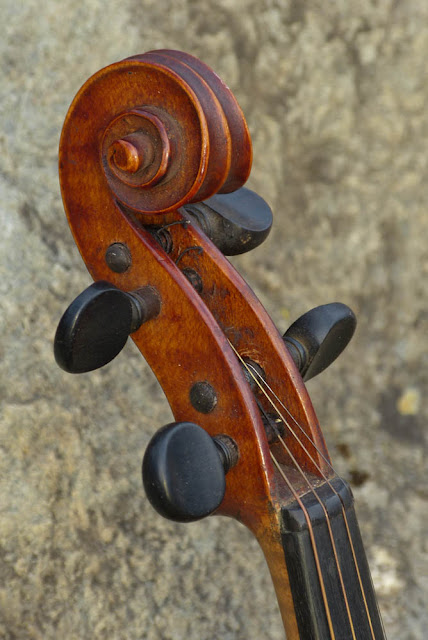1923 Vermont-made Harold Pinney 4/4 Violin
The proud label tells us all we need to know -- that this is a "Strad copy" made by Harold A. Pinney in Rutland, Vermont in 1923. Apparently Mr. Pinney made a bunch as there are many extant examples of his violins pinging around the web from the 20s through the 30s. If they're all as loud and saucy as this one, then they're hum-dingers as well.
American-made violins are becoming more and more interesting to players and collectors these days and are earning a bit more respect. I hope they do come into their own, fully, as instruments like this make very good players in a price bracket far, far below what the market commands for higher-brow European instruments. This one came to me via a customer and was in for seam repairs, cleaning, and a good setup. It still wears older steel-core strings but the tone remains full and vibrant despite that hindrance. I do have a set of John Pearse "Mezzos" on hand to restring it with, however, for that more "Dominant" gut/nylon-core sound that would transform the bass on this into rich chocolate, I'm sure. Action is set close and fast for fiddling.
American-made violins are becoming more and more interesting to players and collectors these days and are earning a bit more respect. I hope they do come into their own, fully, as instruments like this make very good players in a price bracket far, far below what the market commands for higher-brow European instruments. This one came to me via a customer and was in for seam repairs, cleaning, and a good setup. It still wears older steel-core strings but the tone remains full and vibrant despite that hindrance. I do have a set of John Pearse "Mezzos" on hand to restring it with, however, for that more "Dominant" gut/nylon-core sound that would transform the bass on this into rich chocolate, I'm sure. Action is set close and fast for fiddling.
Let's admit it -- it's a pretty, well-carved instrument and that semi-satin finish looks gorgeous with the tight grain of the wood and the "aged cherry" look of the stain.
The board and fittings are all ebony.
There was a fine tuner in the case that I added for the high E string. I also replaced the tailgut with nylon for stability's sake. Note that there are two tiny (1/2") repaired hairline cracks right at the bottom of the tailpiece on the top.
Here you can see some of the carve in the reflections. Yum!
Did I mention that it has a back to die for?
There is a tiny, stable, hairline crack right here on the side (near the chinrest).
It comes with a period case and two shoddy-ish student-quality bows. One has enough hair to play in a pinch, however.
























Comments
Thank you so much